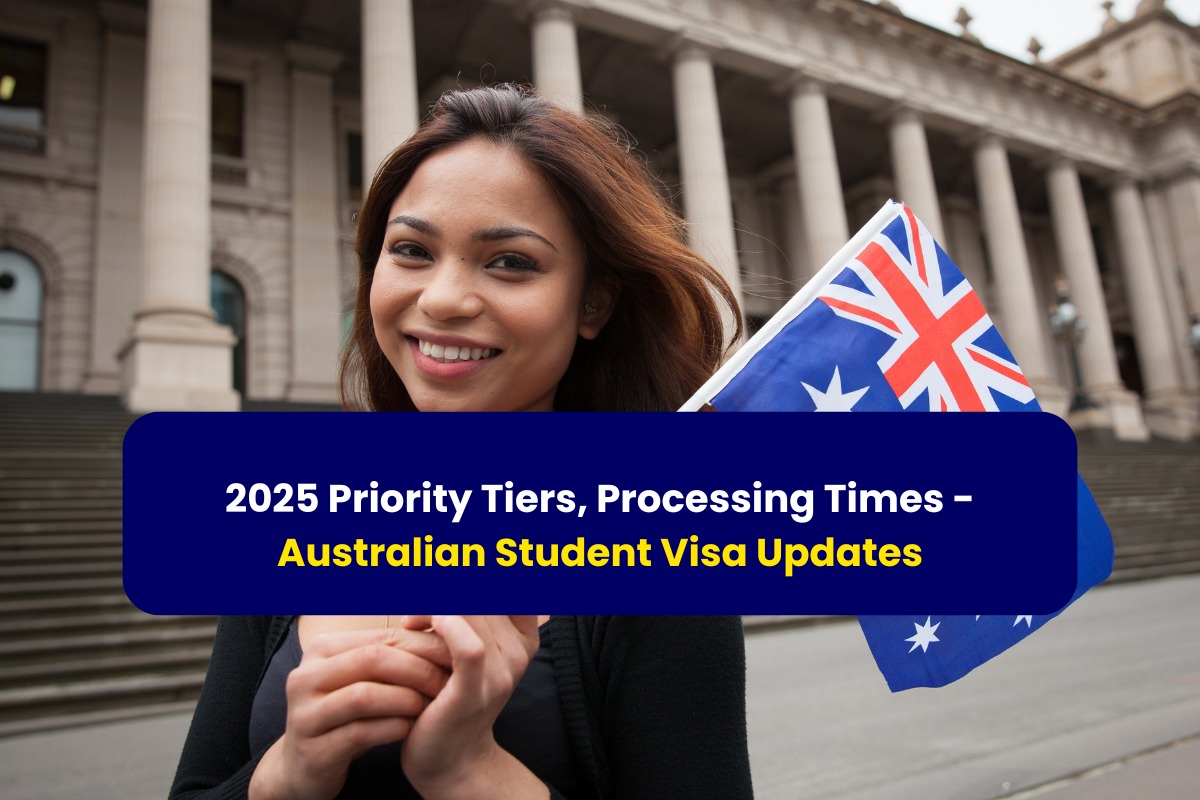2025 Priority Tiers, Processing Times – Student Visa Australia Updates

Student Visa Australia Updates in 2025
Australia introduced major updates to the Subclass 500 visa in 2025. This student visa Australia program is undergoing significant reforms to enhance its credibility and efficiency. Despite challenging enrolment, especially after COVID-19, international students continue to choose Australia for its world-class education, strong post-study work opportunities, and high employability rates.
These updates impact those planning to study in Australia, while attempting to develop a faster and more transparent visa process. Experts consider that the changes will streamline applications while maintaining Australia’s quality of education. So, if you're looking to study abroad after 12th grade or enroll in a top-tier university in Australia, here’s what you need to know to navigate the system smoothly and make the most of your higher studies.
Why Study in Australia?
Australia is a top choice for international students looking for high-quality education, career growth, and a great lifestyle. It ranks highly in the OECD Better Life Index and excels in education, safety, and overall well-being as an ideal study-abroad destination. If you’re looking for an option to study abroad after 12th grade with top-tier education and exciting career opportunities, Australia is the place to be!
World-Class Higher Education Hubs
Australia’s top universities offer degrees that employers highly value. 38 Australian Institutions rank among the world’s best universities and 9 of them are on the top 100 list. Also, the country's PISA scores (499) in reading, math, and science are above the OECD average of 488, reflecting its high-quality education system. This high precedent in academic standards is one of the reasons studying in Australia attracts students from all over the world.
Thriving Job Market & Post-Graduation Opportunities
The country offers international graduates the opportunity to transition from the Student Visa Australia program to a post-study work visa pathway. With this, international graduates can gain work experience and even transition to permanent residency. Fields like IT, healthcare, and engineering offer high-paying jobs with strong demand. To qualify for jobs after graduation, you can develop work experience and professional networks by working part-time as student visa holders.
Exceptional Living Standards & Student Security
With excellent healthcare, stunning landscapes, and diverse cities, Australia offers an outstanding quality of life. It ranks high in work-life balance, making it perfect for students seeking both career growth and personal well-being. Furthermore, around 93% of Australians believe they have someone to rely on in times of need. With a 7.1 life satisfaction score (above the OECD average of 6.7), studying in Australia is not just about earning a degree. It is an experience of a fulfilling and well-rounded life.
Inclusive and Internationally Diverse Society
Australia is home to people from over 200 countries, fostering an inclusive and diverse student community. Cities like Sydney and Melbourne have vibrant cultural scenes, making it easy for international students to feel at home.
Key Updates to the Australian Student Visa Process
The Australian student visa process sees several key updates in 2025, with one of the biggest changes being the introduction of a two-tier priority system for visa processing. This new system, which includes Priority 1 (P1) and Priority 2 (P2) categories, applies to the subclass 500 student visa. The goal is to speed up visa processing for students applying to universities and courses that match Australia’s key priorities.
The two priority classes take into account the new indicative allowances for international student enrolment at Australian universities, whereby each university has to honor a cap of the number of overseas students enrolling for the year.
Here’s how it works:
Priority 1 (P1): Fast-Tracked Visa Processing
With this update, if you apply to universities or courses in priority sectors, your visa application runs through the processing pipeline faster. This means you can start your studies without delay. The system intends to help Australia’s economic recovery and skill development by attracting students to fields with high demand.
Students enrolling in universities which have not reached up to 80% of the indicative allowance of international student enrolments for 2025.
Priority 2 (P2): Standard Processing
If you apply to universities or courses in non-priority sectors, your application goes under Priority 2 or standard processing. While this doesn’t mean a significant delay, students applying to universities already at the 80% enrolment threshold of their indicative allowance for 2025 fall under Priority 2 processing.
Updates to the Student Caps in Australia
In late 2024, the Australian government proposed capping international student enrolments at 270,000 for 2025. However, this bill faced strong opposition including from Australian higher education providers. Instead, a two-tier priority system for student visa processing kickstarted I 2025 to better manage enrolments and align with Australia’s priorities.
Under this new system, student visas from institutions which have yet to reach 80% of their student capacity will undergo processing at Priority 1 (high priority). Once a provider reaches 80% of its indicative allowance capacity, the remainder of its student visa applications will automatically go under Priority 2, which may result in longer processing times.
Additionally, universities with strong research focus or those in alignment with priority sectors (like healthcare or STEM) may also enjoy Priority 1 processing under the current Australia Student Visa program.
General Requirements for International Students in 2025
When applying for a Subclass 500 visa in 2025, there are several key requirements that you must meet. These requirements ensure that you are eligible to study in Australia and that you comply with visa conditions. Here's a detailed breakdown of the essential documents and conditions you need to submit:
Personal Identification:
You must provide a valid passport or other official identification documents. This verifies your identity to the government and usually the official travel document that allows you to travel in and out of Australia.
Genuine Student (GS) Requirement:
The Genuine Student (GS) requirement replaces the previous Genuine Temporary Entrant (GTE) requirement. This means that you need to prove that you intend to study in Australia temporarily and that you will return to your home country after completing your studies. This includes showing that you have a genuine interest in the course you are enrolling in and that your personal and professional background aligns with your study plans.
Proof of Enrolment:
You must provide a Confirmation of Enrolment (CoE) from your Australian educational institution. The CoE is an official document from the university or college that confirms your acceptance into a full-time course at a CRICOS-registered university.
IELTS Requirements:
For most student visa applicants, the IELTS score requirement for a student visa is 6.0. However, specific institutions or programs may require higher scores. Ensure you check the requirements of your institution and program before you apply.
Proof of Funds:
You must prove that you have sufficient financial resources to cover your tuition, living expenses, and other costs while studying in Australia. Typically, you need to show:
⦁ AUD 21,041 for living costs per year.
⦁ Evidence of your tuition fee payments (usually for one year).
⦁ Proof of additional funds for accompanying family members, if applicable.
Police Clearance Certificate
You need to submit a police clearance certificate to prove that you have no criminal record. This is typically a requirement for any country you lived in for over 12 months over the past 10 years.
Medical Check Reports:
A medical examination is a requirement to ensure that you meet the health standards Australia aims to uphold for its community. You must find a verified panel physician for this check-up in your country. Health checks are essential for long-term visa holders.
Biometrics:
Biometrics (fingerprints and facial recognition) are requirements as part of your visa application. This helps the Australian government to verify your identity and check for any security or immigration risks.
Proof of Employment (If Applicable):
If you are working while applying for a student visa, you must provide proof of employment. This could include pay slips, employment contracts, or tax records. This helps demonstrate that you have the financial ability to support yourself during your studies.
Additional Documents:
In some cases, you may also need to provide additional documents, such as:
⦁ Academic transcripts or qualifications from previous studies.
⦁ A statement of purpose explaining why you want to study in Australia and how it fits into your long-term career goals.
Tips for a Successful Student Visa Application
Acing student visa Australia processing in 2025 can be challenging, especially with the new changes. Here are some tips to help you successfully manage the process:
Choose the University or Sector that Aligns with You
While researching your universities, remain mindful of the indicative allowances of each institution. Some universities have more flexibility to enroll international students than others. Your first priority, however, should always be finding the program that best matches your future goals, academic profile, budget, and so on. With a strong application, you can crack admissions for any of Australia’s world-ranking universities, which in turn gets you a step closer to getting through Student Visa Australia processing with ease.
Complete All Documentation Requirements:
Ensure that you submit all necessary documents, including personal ID, proof of enrollment, biometrics, and a police clearance certificate. Missing even one document can delay your visa approval or risk complete rejection.
Provide Proof of Sufficient Funds:
You’ll need to demonstrate you have enough funds to cover tuition, living expenses, and return travel. Be ready with bank statements or a financial guarantee from a sponsor.
Prepare for Medical Check:
Make sure that you find and sign up for a medical check-up with a verified panel physician.
Provide IELTS Scores:
You might already have English language proficiency scores from your university application. As long as your band score is at or above an overall IELTS 6.0 or equivalent, this is sufficient for the visa application too.
Fulfill the Genuine Student Requirement (GSR):
This requirement ensures that your primary intention is to study. Prepare to demonstrate your academic goals and future plans clearly.
⦁ Plan Ahead for Processing Times: Whether applying under Priority 1 or Priority 2, start your application early. While Priority 1 offers faster processing, Priority 2 applicants will still have a reasonable timeline. Early applications help ensure timely approval.
⦁ Stay Up-to-Date: Immigration policies can change. Stay up to date on the latest requirements to avoid last-minute issues.
Rounding Up
Don’t let the updated student visa Australia processing news discourage you. These changes can, in fact, make the application process quicker and more efficient, especially for high-demand sectors. If you’re applying to priority courses at universities with more flexibility for international enrolments, expect faster processing times to kick off your studies sooner. Make sure to meet all the visa requirements during your application and you'll be ready to start your exciting journey to study in Australia in no time!



